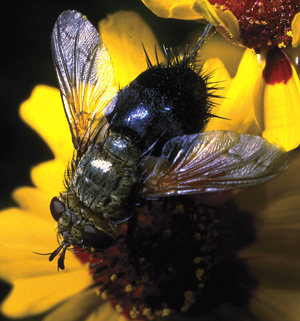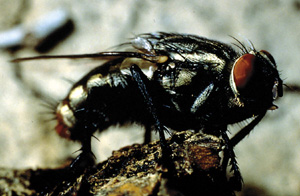
Adult Tachinid Fly

Flesh Fly
Click on image to view larger.
|
Parasitic flies
Description:
Adult tachinid flies can resemble houseflies, but vary by species in size, coloration and shape. Many are gray or black or have bodies marked with stripes and have distinct long bristles on the ends of their abdomens. Some species are brightly colored.
Benefit:
Individual species are generally host-specific. As a group, most species parasitize caterpillars or beetles. However, some species develop in sawflies, true bugs, grasshoppers or other insects.
Life cycle:
Life cycles vary by species. Eggs are sometimes oviposited on leaves and ingested by a host larva during feeding. Females of other species may glue their eggs to the host body after which the hatching larva tunnels inside. In other species, eggs are inserted directly into the host body. Once inside the host body, one or more larvae can develop through several instars for 4 to 14 days. They emerge from the host to pupate inside their last larval puparium. Adults emerge 1 to 2 weeks later. Depending on species, 1 or more generations occur per year.
|